Best Solar Panel Kits for Cargo Trailer Conversions (with Battery & Inverter)
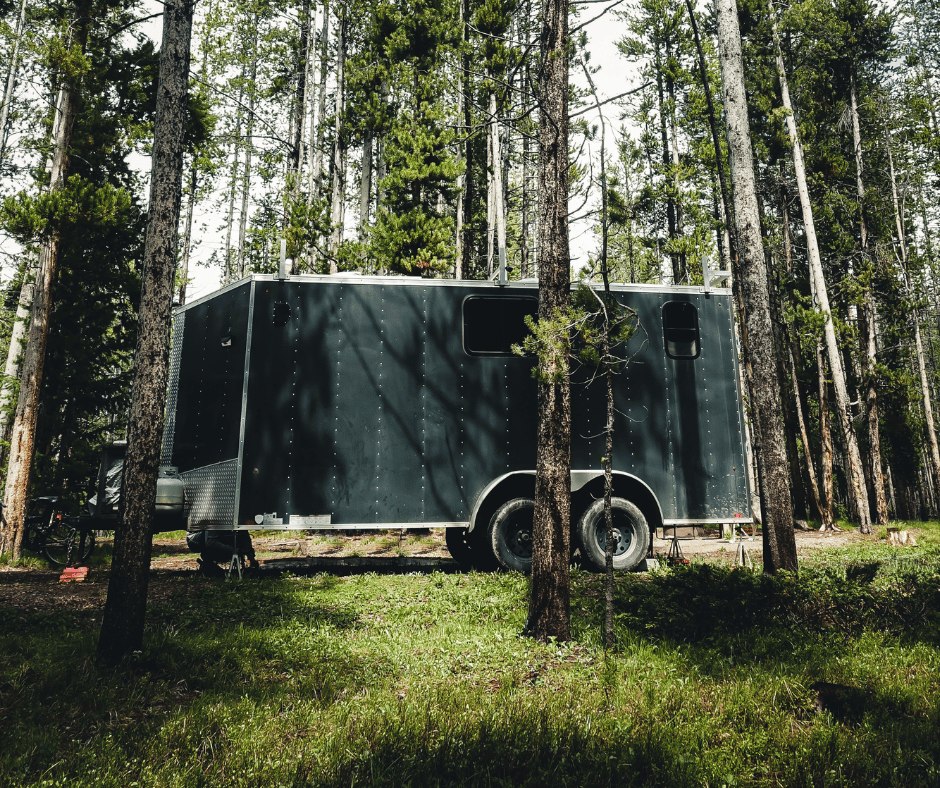
In 2018, my husband and I converted a 7X16 cargo trailer into our very own tiny home on wheels and hit the road full-time. And let me tell you, it has been one heck of an adventure.
But there was one thing that constantly kept us on edge—our power source.
And let me tell you, selecting the right solar system is not always straightforward. In fact, it often involves a fair amount of trial and error.
In our experience, it took multiple attempts and upgrades until we finally had a system that met our power needs.
Each time we made adjustments, we learned valuable lessons about what features and components were essential to our system’s functionality and efficiency.
In this blog post, I will provide you with all the information you need to confidently choose the right solar panel kit for your cargo trailer camper conversion, without any guesswork.
Table of Contents
ToggleChoosing the Right Solar Panel Kit for Your Cargo Trailer Conversion
You’ve made the decision to upgrade your cargo trailer conversion with a solar panel kit—high five to that!
But, now comes the fun part—choosing the right kit for your needs and budget.
What you will need in an enclosed trailer solar setup
When it comes to setting up a solar panel installation, there are several components that you’ll need to consider. These include solar panels, a charge controller, an inverter, and batteries. Here’s what they do and why they are important:
Solar Panels: These are the most critical component of a solar power system. They are responsible for converting sunlight into electricity.
Charge Controller: A charge controller regulates the amount of current that flows from the solar panels to the batteries. It protects the batteries from overcharging, which can damage them.
Batteries: Batteries store the electricity produced by the solar panels. They are particularly important if you are using solar power to supply your cargo trailer with electricity during periods of low sunlight.
Inverter: The inverter takes the DC power generated by the solar panels and stored in the batteries, and transforms it into AC power, which is compatible with the electrical devices in your cargo trailer.
How Many Solar Panels Do I Need for My Cargo Trailer Conversion
First things first, you need to consider your specific needs. How much power do you need? How much storage space do you have in your cargo trailer? What’s your budget?
These are all important factors to keep in mind when choosing the right solar panel kit for your enclosed trailer.
To start, you should measure the space where you plan to mount the panels. The amount of available roof space will vary depending on the size and shape of your cargo trailer.
For example, we initially started with two 100-watt solar panels attached to the roof of our 16-foot cargo trailer. Later on, we bought four additional panels, allowing us to install a combined total of six compact 100-watt panels on our trailer.
To determine how many solar panels you need to power your devices, you first need to calculate the daily energy requirement of the solar panels. This is based on the total power consumption of all the devices and the amount of sunlight available in your location.
Let’s say you want to power your laptop, LED lights, phone charger, mini fridge, and fan for 24 hours, and the total power consumption of all these devices is 2,200 watt-hours (Wh).
If you receive an average of 5 hours of sunlight per day, the daily energy requirement of the solar panels would be:
Daily energy requirement = Total power consumption / Number of sunlight hours per day
= 2,200 Wh / 5 hours
= 440 watts
This means that you need solar panels that can generate 440 watts of power per day. However, this calculation doesn’t account for any inefficiencies or losses in the system.
To be safe, you should increase the daily energy requirement by 25%, which would bring the total to 550 watts.
Next, you need to determine the wattage of the solar panels you need based on the daily energy requirement.
Let’s assume you use 200-watt solar panels. To calculate the number of solar panels you need, divide the daily energy requirement by the wattage of each solar panel:
Number of solar panels = Daily energy requirement / Wattage of each solar panel = 550 watts / 200 watts = 2.75
Rounding up to the nearest whole number, you would need 3 solar panels to generate enough power to run all your devices for 24 hours.
Flexible Solar Panels—Are they Worth it?
Flexible solar panels have become popular due to their lightweight design and no need for drilling holes in roofs, but they are expensive compared to traditional panels.
Additionally, they are not as durable as rigid solar panels, and the flexible material can crack, peel or delaminate over time.
Another potential issue with flexible solar panels is that they can generate a considerable amount of heat. This can cause significant damage to the roof or even start a fire in extreme cases, which is a serious safety concern.
Our verdict—we do not recommend them.
Picking Batteries for Cargo Trailer Conversion—Lithium or Lead Acid?
When the sun is shining, solar panels can generate a good amount of power. However, the real challenge of a solar setup is how efficiently it can function when the sun is not available. That’s where the batteries come in.
Selecting the appropriate batteries is a crucial aspect of creating your solar system. Aside from being the bulkiest component, batteries also tend to be the priciest.
When it comes to choosing batteries for your cargo trailer conversion, there are two main options to consider: lithium and lead-acid batteries. Let’s take a look at both and see which may be the better choice for your needs.
Lead Acid
Lead-acid batteries are a traditional choice and have been around for a long time. They are relatively inexpensive, widely available, and easy to replace. However, they tend to be heavier, bulkier, and require more maintenance compared to lithium batteries.
Additionally, lead-acid batteries have a lower usable capacity compared to lithium-ion batteries. This means that to get the same amount of usable energy from a lead-acid battery as a lithium-ion battery, you would need a higher capacity rating in amp-hours.
Lithium Ion
On the other hand, lithium batteries are more expensive upfront, but they offer a host of benefits. They are significantly lighter and more compact than lead-acid batteries, making them easier to install and transport.
They also have a longer lifespan and higher cycle life, meaning they can endure more charge and discharge cycles than lead-acid batteries. Lithium batteries also require less maintenance and can charge up faster than lead-acid batteries.
If you want the best of the best, you gotta check out Renogy and Battle Born. They are two of the leading brands of lithium-ion batteries in the industry. Here’s why:
Renogy
These batteries are known for their high-quality construction and impressive lifespan. They come in a variety of sizes, from 12V to 24V, so you can choose the perfect one to meet your power needs. And the best part? Renogy batteries are super easy to install and maintain, so you can spend more time enjoying your adventures on the open road.
Battle Born
These batteries are the cream of the crop when it comes to lithium-ion power. They boast an impressive 100-amp hour capacity and can be charged up to 100% in just a few hours. Plus, they’re built to last, with a lifespan between 3,000-5,000 cycles. That’s a lot of power for your cargo trailer!
How Many Batteries Do I Need for My Cargo Trailer?
So, how many batteries do you need for your cargo trailer? Well, that depends on a few factors. First, you’ll want to determine how much power you’ll need on a daily basis. This will depend on the appliances and electronics you plan to use, and how often you plan to use them.
To get an estimate of your power needs, start by making a list of all the appliances and electronics you plan to power with your solar system, along with their wattage ratings. This might include things like a mini fridge, LED lights, laptops, cell phones and a max air fan.
Once you have a list of all your power needs, you can calculate the total wattage by adding up the wattage of each appliance.
For example, assuming you want to power the following devices for 24 hours (with no solar input during this time):
- Laptop: 50 watts x 24 hours = 1,200 watt-hours (Wh)
- LED lights (4): 10 watts x 24 hours = 240 Wh
- Phone charger: 10 watts x 24 hours = 240 Wh
- Mini fridge: 50 watts x 24 hours = 1,200 Wh
- Fan: 20 watts x 16 hours = 320 Wh
Total power consumption for all devices: 2,200 Wh
To calculate the size of the battery amp hour (Ah) you would need, you would first need to determine the voltage of the battery system. Let’s assume you’re using a 12-volt battery system.
For a lithium-ion battery, you would need a battery with a capacity of at least 184 Ah to power all the devices for 24 hours before needing to be recharged. In this example, you would need at least two 12V lithium-ion batteries, each with a capacity of 100 Ah.
For a lead-acid battery, you would need a battery with a capacity of at least 460 Ah. In this example, you would need three 12V 200Ah deep cycle lead acid batteries to power all the devices for 24 hours before needing to be recharged.
What Size Inverter Do I Need for My Cargo Trailer Conversion?
If you’re hoping to power AC appliances, you’ll need an inverter to convert your cargo trailers DC battery power to AC power.
But what size inverter do you need?
To determine the wattage capacity of an inverter, you need to consider the maximum amount of power (in watts) that the appliances or devices you want to power will require at any given time.
This is called the “peak power” or “surge power” rating. You also need to consider the “continuous power” rating, which is the amount of power the inverter can supply continuously over a longer period of time.
To do this, you should first identify the appliance that draws the most power, such as a toaster or a mini-split air conditioner.
Once you have identified the highest power-consuming device, you can add other devices that may be in use at the same time, such as a mini fridge, LED lights and a laptop.
You should then calculate the total maximum power consumption by adding the wattage of each device.
Let’s say you have a mini split system that uses 1200 watts on startup, and you want to power a laptop (50 watts), LED lights (40 watts), and a mini fridge (50 watts).
To calculate the total power consumption, you add up the wattage of all the devices:
1200 watts (mini split) + 50 watts (laptop) + 40 watts (LED lights) + 50 watts (mini fridge) = 1340 watts
To choose an inverter, you want to make sure it can handle the total power consumption plus a bit extra for safety, so you’ll want an inverter that’s at least 50% larger than the total wattage = 2040 watts.
In this scenario, you would choose an inverter with a continuous power rating that is 2500 watts to ensure reliable operation.
Victron Inverters
While there are many inverter options available, Victron pure sine wave inverters are often considered one of the best due to their efficiency and reliability.
They are available in different power ratings ranging from 800 watts to 5000. However, it may not be the most budget-friendly option for everyone.
One of the main reasons why we love Victron products is the ability to monitor everything with the VictronConnect app.
It allows us to connect to our Victron inverter via Bluetooth and access real-time data on the performance of our set up.
The app allows us to view information such as the current state of charge of their batteries, the amount of energy being produced by our solar panels, and the amount of power being consumed by our appliances.
We can also set custom alerts for low battery voltage, over-temperature warnings, and more, ensuring that we are always aware of any potential issues before they become a problem.
Renogy Inverters
However, If you’re looking for a more budget-friendly inverter, the 2000-watt Pure Sine Wave Inverter from Renogy could be a great option. For around $600, this type of inverter can provide clean and stable power that is perfect for a cargo trailer conversion.
Cargo Trailer Solar Kit Examples
In general, a good starting point for a cargo trailer solar system is around 400 watts of solar power, paired with a battery bank that can store at least 200 amp hours of energy, a charge controller, and a pure sine wave inverter with 2000 watts of continuous power output.
This should be enough to power basic appliances and electronics for a weekend trip or short-term use.
If you plan to use more power-hungry appliances, such as an mini split A/C unit or if you plan to live in your enclosed trailer full-time, you may need a larger solar system.
One example of such a system would be 600 to 800 watts of solar panels, a high-quality Renogy charge controller, 400 amp hours of lithium-ion batteries (such as the Battle Born or Renogy brands), and a pure sine wave inverter with 2500-3000 watts of continuous power output (such as the Victron Energy MultiPlus).
Building your Cargo Trailer Conversion solar panel kit (our recommendation)
And now, for the moment we’ve all been waiting for—our top recommendation for the solar panel kit to use in your cargo trailer conversion.
If we were to do it all over again and build a solar power system for our cargo trailer with what we know now, there’s no doubt that this is what we would recommend:
Renogy Solar Panel kit
The Renogy solar panel kit comes with everything you need to get started, including solar panels, a charge controller, mounting hardware, and wiring.
The panels are made with high-efficiency monocrystalline solar cells that can generate plenty of power even in low light conditions. The charge controller helps regulate the flow of power to your batteries, ensuring that they are charged efficiently and safely.
Victron Pure Sine Wave Inverter
The Victron 2000 W 12V Pure Sine Wave inverter charger is a top-of-the-line option that converts the DC power stored in your batteries into clean and stable AC power that can be used to power a range of devices and appliances.
The Victron inverter is known for its reliability and efficiency, making it an excellent choice for those looking for a high-performance inverter.
Battle Born Batteries
Finally, the 100Ah Battle Born 12V batteries are some of the best lithium-ion batteries available. They are highly durable and long-lasting, and can provide plenty of power for your system.
Unlike traditional lead-acid batteries, lithium-ion batteries are more efficient, have a longer lifespan, and are much lighter, making them an ideal choice for those who need to conserve space and weight.
FAQ—Solar Panel Kits for Cargo Trailer Conversions
How long do solar panel kits last?
Solar panel kits can last for a long time, typically anywhere from 25 to 30 years or even longer with proper care and maintenance. Of course, the lifespan of a solar panel kit can be influenced by a variety of factors such as the quality of the components, the frequency of use, and the environmental conditions in which the system is used.
Enclosed Trailer Solar Panel Kits Final Thoughts
We absolutely love sharing our cargo trailer conversion journey with you, and we hope that it has been a helpful resource for anyone who is considering embarking on their own conversion project.
Whether you’re a full-time traveler, weekend warrior, or just looking for a mobile workspace, a cargo trailer conversion can offer endless possibilities and freedom. We understand that every conversion project is unique, and we hope that our experiences and insights have provided some inspiration and guidance.
And if you’re thinking about adding a solar panel kit to your conversion, we highly recommend it as a great way to enhance your off-grid capabilities and reduce your environmental footprint.
Thanks for following along, and we wish you all the best in your own conversion adventures.
If you have any questions, leave them in the comments below, or check out some of our other resources for cargo trailer conversions.



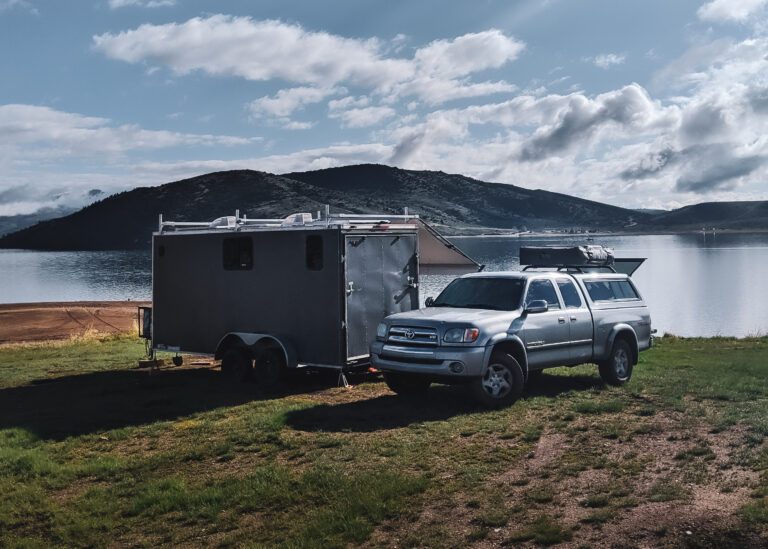
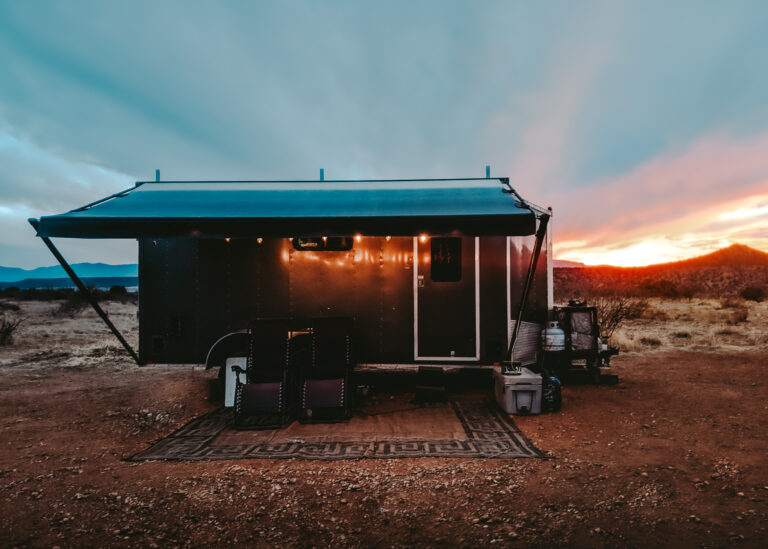

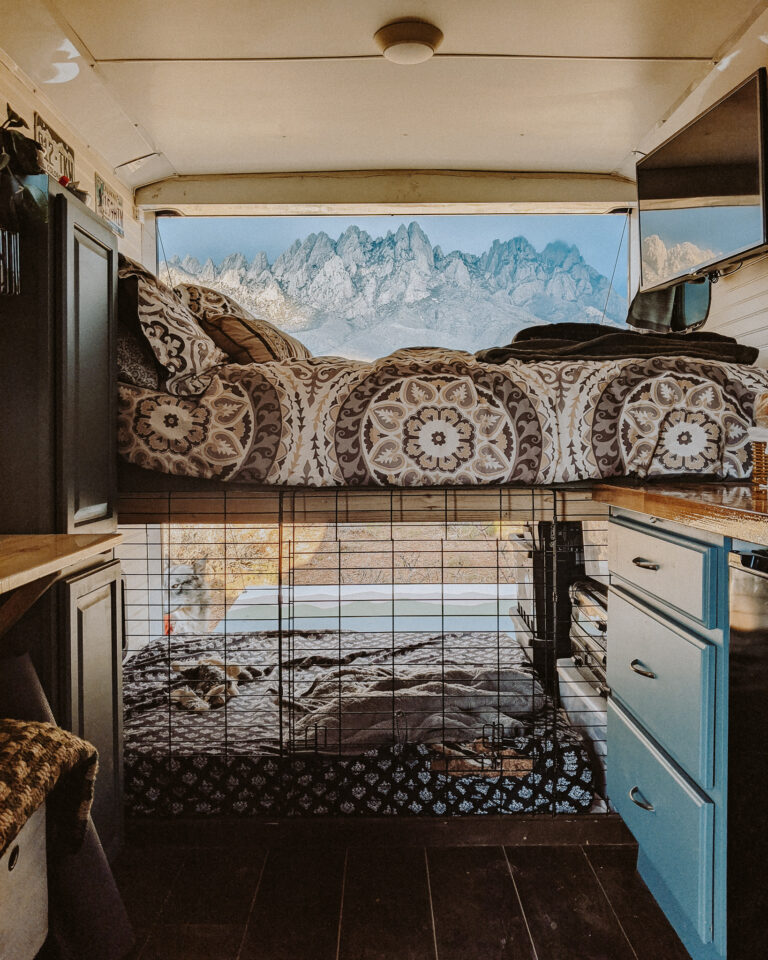
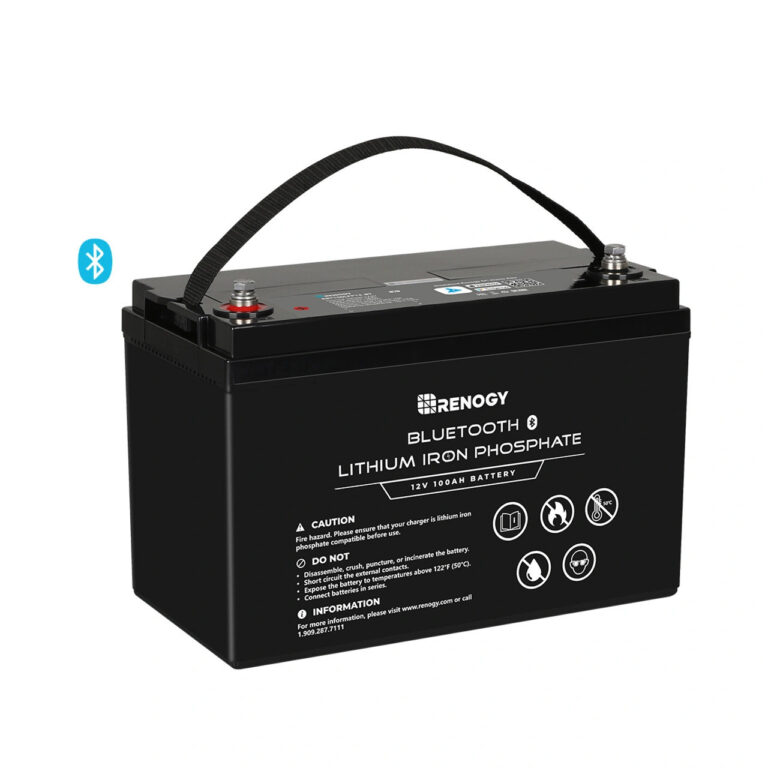
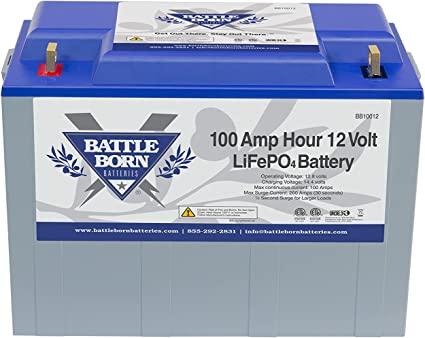
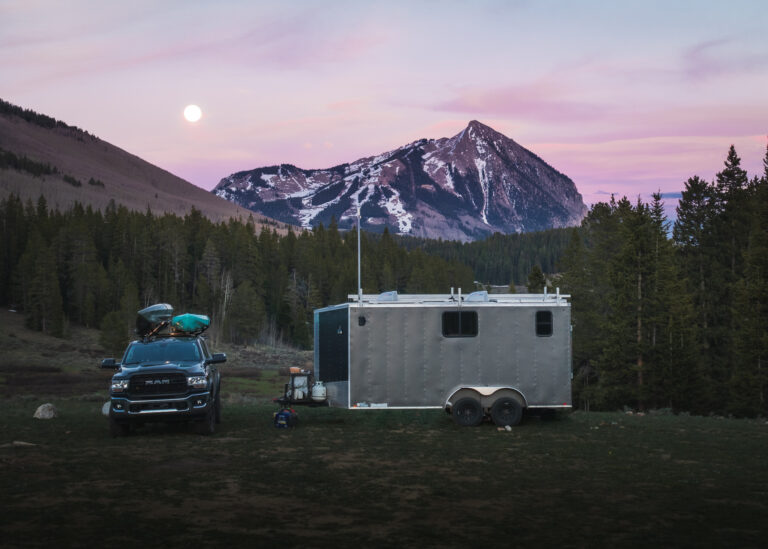
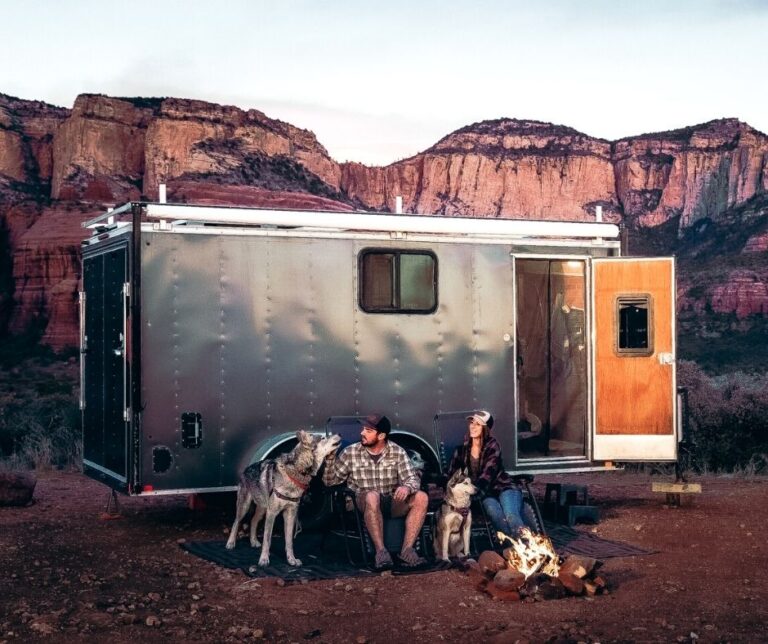
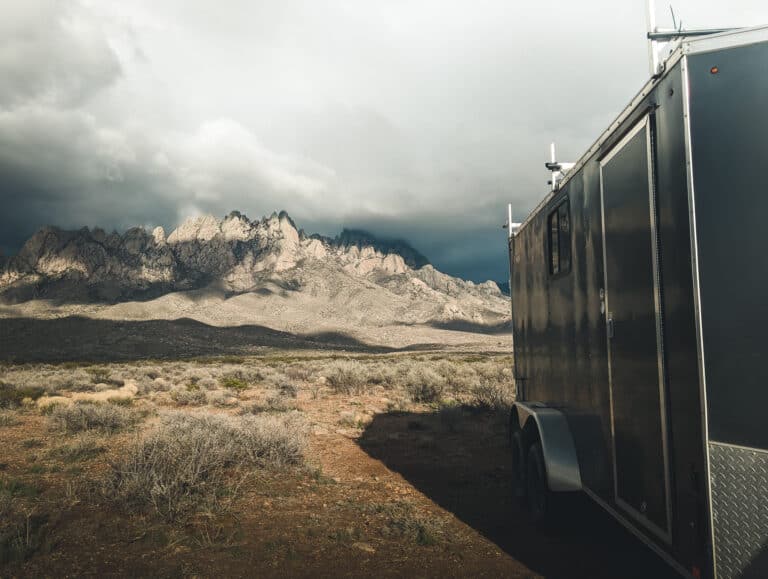
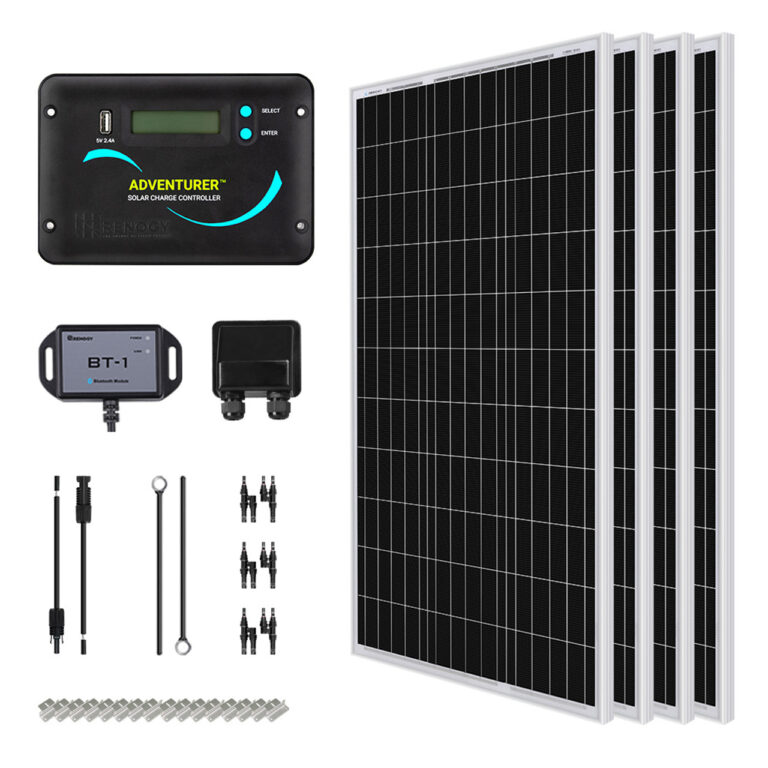
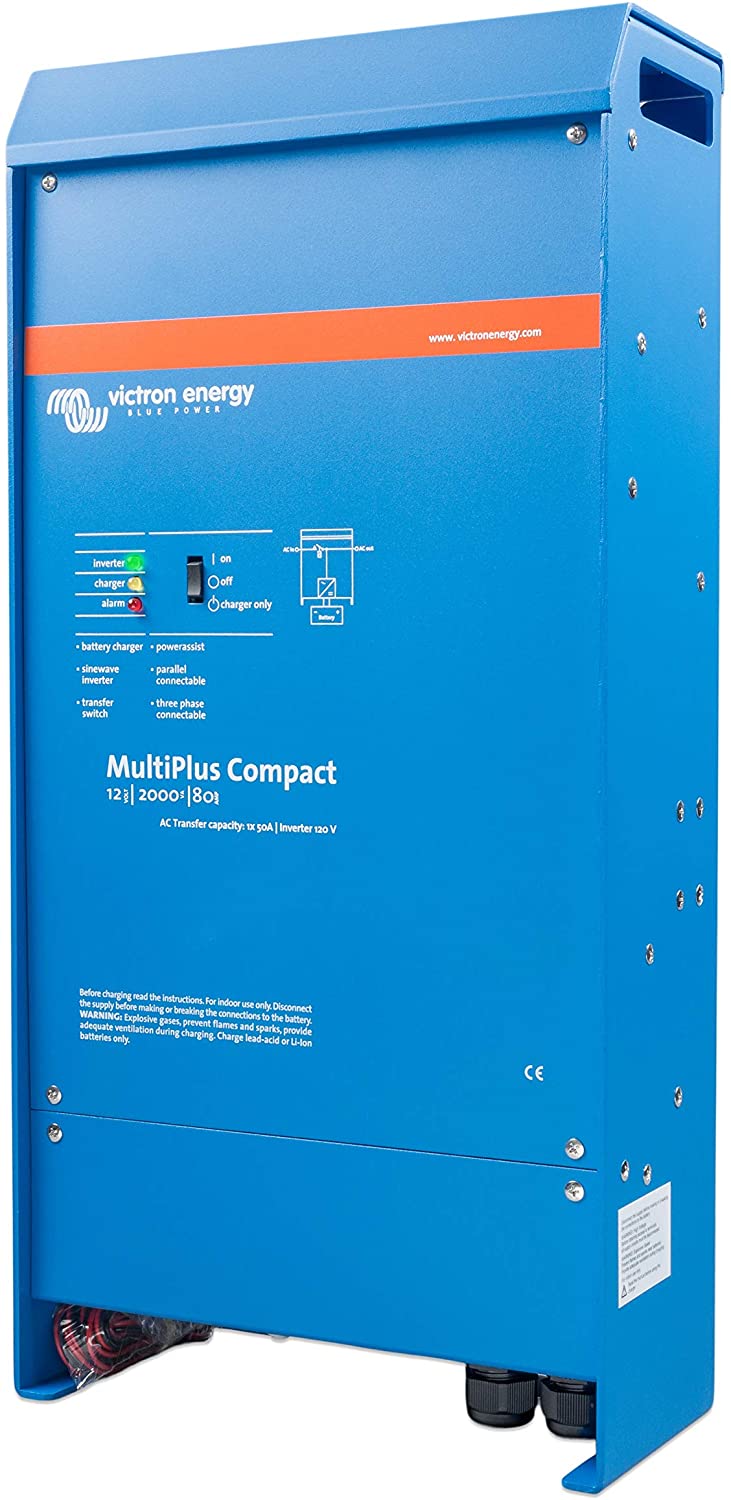
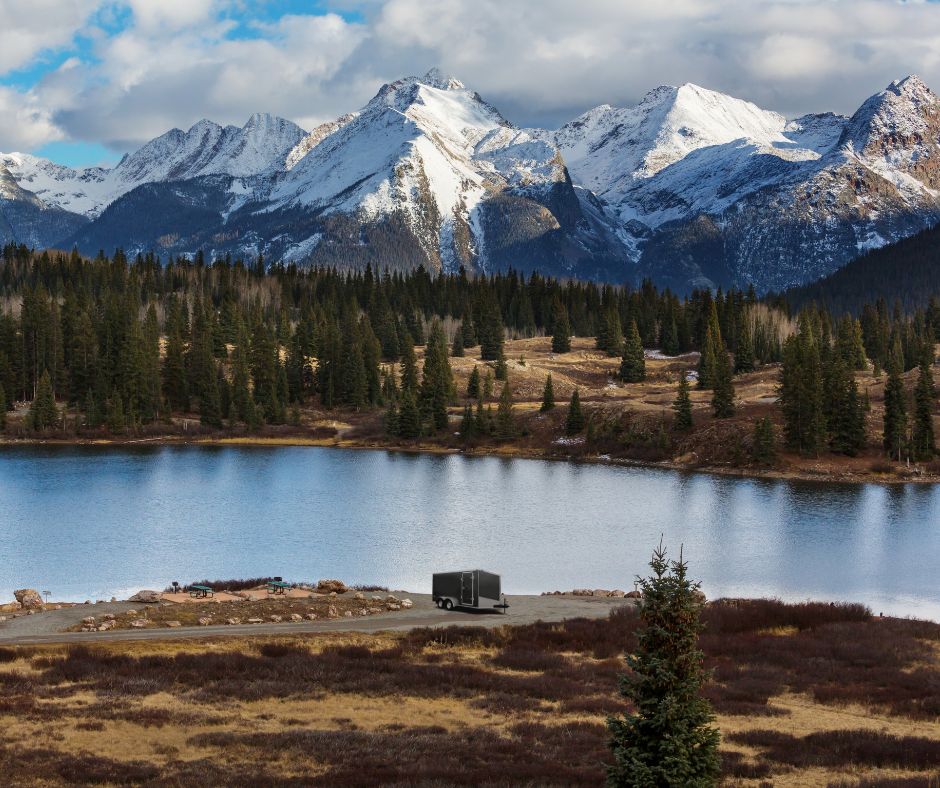
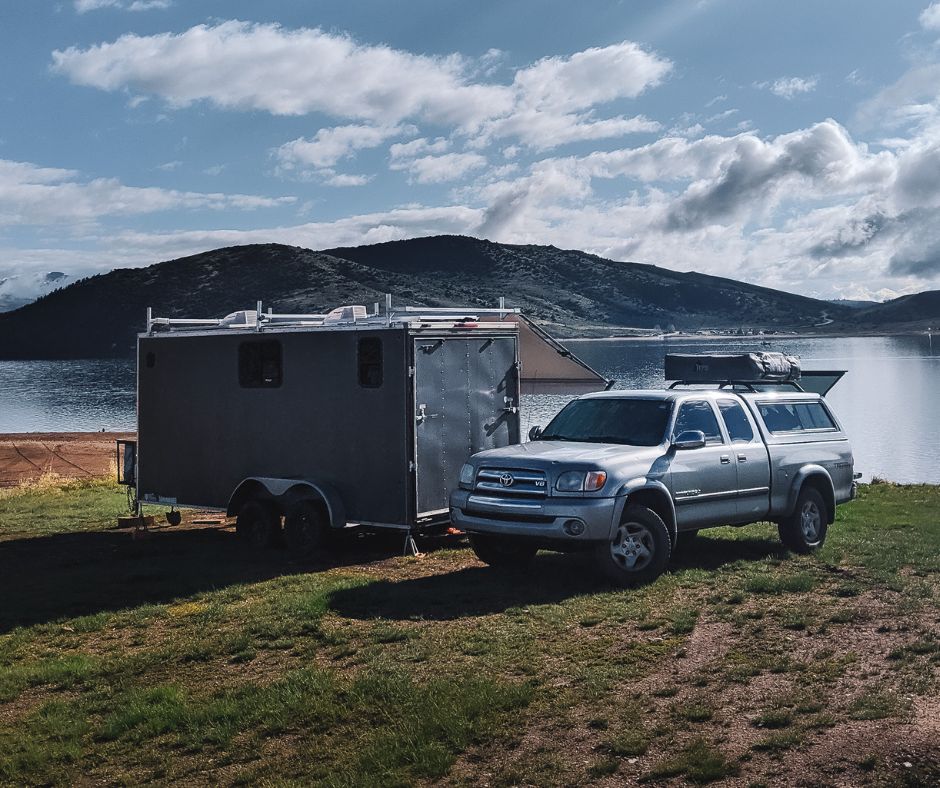
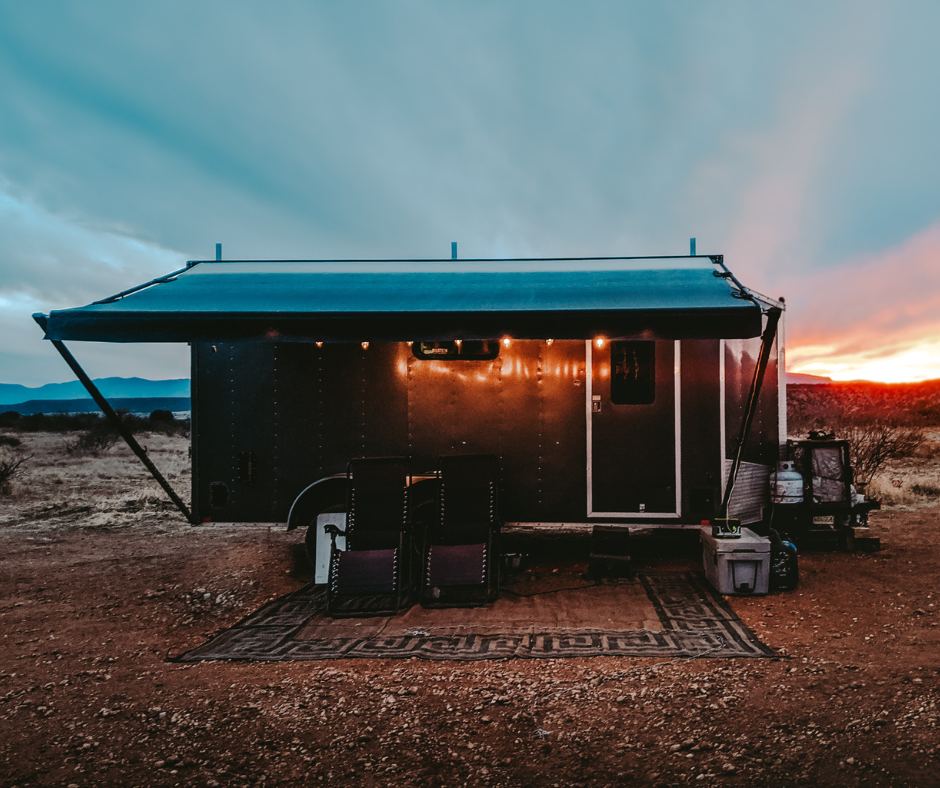
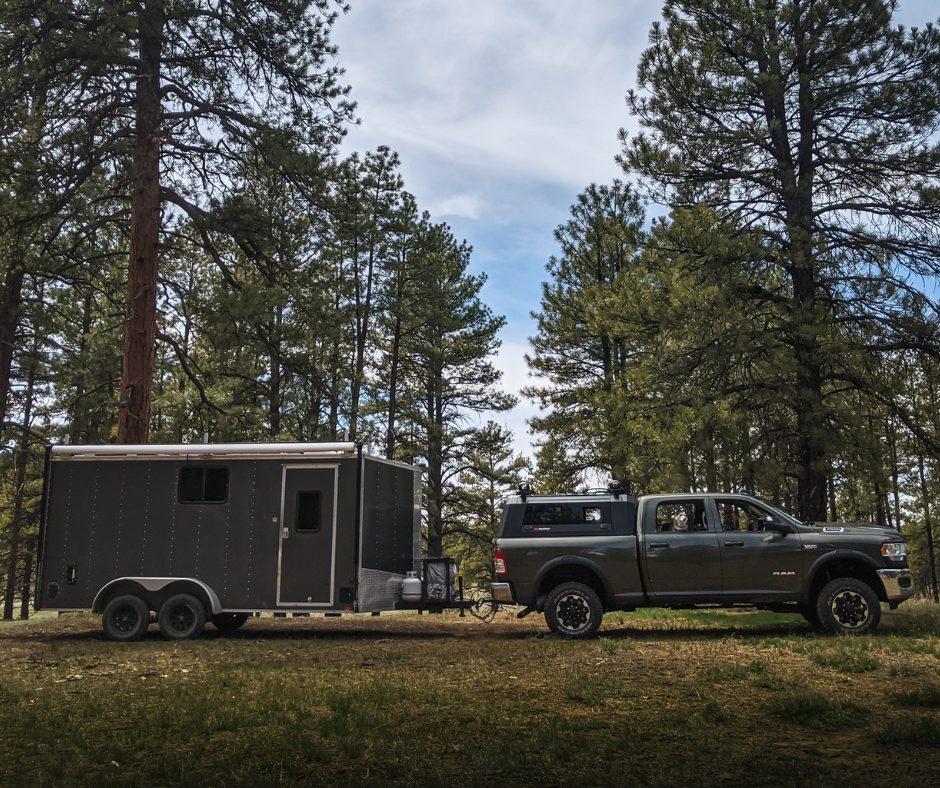
This is great! Thank you for sharing your knowledge and experience on this! We are just getting started in our cargo conversion.
One question I have, a recommendation on A/C units? We are especially concerned about keeping our cargo trailer cool in the summer.
I’m so glad you found it helpful! I was actually thinking of writing a post about the different A/C options for cargo trailer conversions, so I’m glad you brought it up! We chose the Senville Mini Split for our CTC because it offered a perfect combination of efficiency, compact size, and reliable cooling and heating capabilities.
great information. What do you recommend for a 7 by 14 enclosed trailer off the grid? 24 hours a mini-split AC/heater system, cell phone, laptop, lights, and toaster. how many watts of solar, inverter compacity, and batteries would you recommend?
I was thinking around 800 watts of solar. and two batteries.
We’re glad you found it helpful! Well, if you want to power your mini split A/C unit with solar panels, you will need a 3000-watt inverter, at least 600 Ah of lithium-ion batteries, and approximately 1200 watts of solar panels. And that probably wont power you for 24 hours running a mini-spit. You would be better off investing in a generator to save money on such a large solar set-up. But, to power everything else, 800 watts of solar panels is great, 400 amp hours of lithium-ion batteries (such as the Battle Born or Renogy brands), and a pure sine wave inverter with 2500-3000 watts of continuous power output (such as the Victron Energy MultiPlus) should definitely keep you powered for 24 hours!
What do you use for a roof rack? I’m looking for options to install my solar panels.